Living lab for city logistics
Type of solution: Governance
Node: Rotterdam
Link or contact: https://greendealzes.connekt.nl/en/living-labs/living-lab-rotterdam/
Since 2014 Rotterdam uses a ‘Living Lab’ approach in city logistics in which the city works together with partners on technical, logistic, behavioural, law, policy and communication aspects. In the previous years the city has acknowledged Ecostars as a system for transport companies, introduced a environmental
protection zone in the city centre, and on national level, made appointments between stakeholders about a green deal zero emission city logistics. In order to achieve the goals of the Living Lab approach, knowledge exchange and communication are key elements. The focus within the approach is on transporters and shippers, but more and more attention is given to the buyers as well, due to their impact on the zero emission goals. Within logistics, companies are supported through the Beter Benutten programme, decoupling and bundling points and smart procurement. The pilots that are being carried out provide opportunities to experiment with future solutions, which is necessary because achieving the goals of the zero emission policy involves a lot of aspects which transport companies do not want to take care of themselves.
Together with partners, it is nevertheless possible to achieve certain goals by asking the question what one can do to strengthen the total. For example the port is not only a gateway to Europe, but also creates value. One concrete example of an outcome is the company of Breytner as the first complete electric transport company for urban delivery of goods and services.
